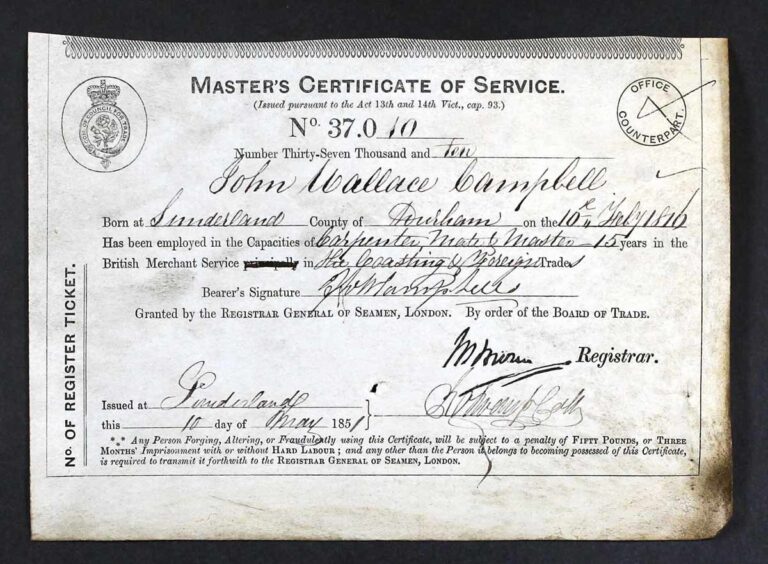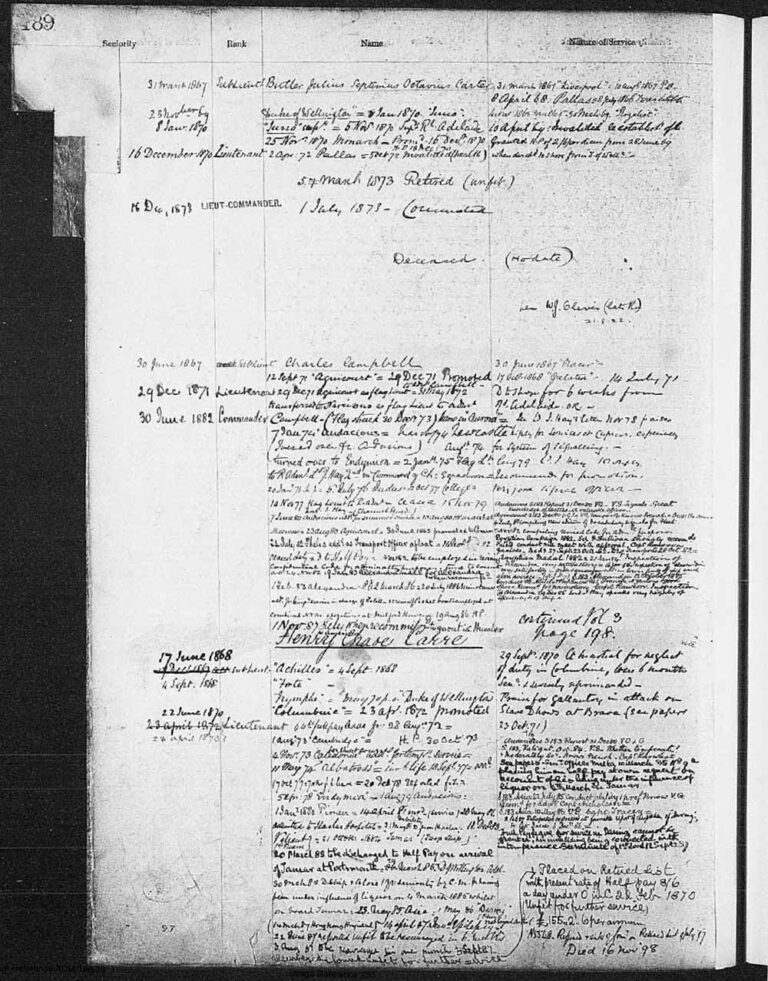Trying to trace a merchant seaman in the later parts of the 19th century is fairly difficult. There are no records of service, ‘pouches’, or central records. If you know the name of ship, then you can trace their service back through crew lists and agreements but otherwise you need to consider other avenues.
Fortunately, for officers, there are registers of certificates for masters and mates. These give certificate number, date and place of birth and date and place of where certified. They also give details of voyages.
These records are now searchable on Discovery by name, details of birth or certification. This is thanks to our offsite volunteers.
Duplicate and questions
These records are available to download from our catalogue, in the series BT 124. Previously, researchers needed to search the indexes in BT 127, obtain the certificate number, and then locate that number in the ranges of certificate numbers to use the register information. Indexing the records on our catalogue provides an alternative to an in-person visit to view the indexes on microfilm.
Our remote volunteers captured the personal details of Masters and Mates, using the transcription website fromthepage.com. We upload digital copies of the microfilm and set up a form to capture the data.
One of the first problems was the quality of the digital microfilm. The records were microfilmed over 30 years ago, more recently scanned as digital copies. The films include blank pages and in some cases duplicates. Upon realising this the volunteers soon ignored the duplicate pages.
Another question was why are we doing this? The records are already searchable on Ancestry.co.uk. This highlighted the overlap in records held between us and other archives. In this case the National Maritime Museum (NMM). Their records are the applications for the certificates and the actual certificate. The two sets of records complement each other with the application and the Register General of Shipping and Seamen’s (RGSS) record. The RGSS register shows the voyages and indicates if a seaman died at sea.
NMM or RGSS
The NMM certificate for John Wallace Campbell, born in Sunderland, indicates he was a merchant seaman for 15 years. The application lists the particulars of his service from apprentice in 1832 to Master in 1850.
The RGSS register in BT 124/1 records his service from 1851. This also records his death at sea in 1856. Most of these deaths at sea are not recorded in other records. The Master or Captain was responsible for recording deaths at sea in the ship’s log.

Our band of volunteers also used genealogical sites to confirm the dates and places of birth if this wasn’t clear. Establishing St Andrews, NB is New Brunswick, not North Britain as used by the War Office at this time.

From royal to merchant
The records also include records of former Royal Navy personnel. John Gabriel Yarwood Holbrook was born in Devonport, in 1840. He joined the Royal Navy as a Cadet in 1854. He retired as a Commander on 22 February 1872 (ADM 196/14/399). On 17 April 1877 he was certified as a Master, issued at Quebec (No 76305).
Butler Julius Septimus Octavius Carter. Born in Gosport in 1846, retired (unfit) as a Lieutenant Commander, Royal Navy, 1 July 1873. He was then certified a Merchant Seaman Master on 11 April 1877, in London. His father was a Captain, RN and Superintendent of Haslar hospital. There are two copies of Butler’s baptism record at Haslar hospital, Alverstoke, one held by the Portsmouth History Centre and another with The National Archives. The National Archives copy is in the records series ADM 305/86, Register of baptisms at Haslar hospital. Both are available to download from Findmypast.co.uk. The 1861 census lists him as a Naval Cadet, HMS Britannia, Portsmouth Harbour.
Another officer was Charles Eustace Anson, a descendant of British Royal Navy officer George Anson. Charles’ Masters’ Certificate of Service records, dated 11 February 1886, states he had served 11 years with the Royal Navy. He had taken half pay leave in 1885. There are two files for his Royal Navy service in ADM 196. The first (ADM 196/38/24) lists his service from entering on 15 July 1872 until 15 May 1911 when a Rear Admiral. This lists details of his promotions and allowances. The second record (ADM 196/87/126) continues until he retired as an Admiral on 3 April 1919. BT 124/23 records his certificate, but no voyages.

How to search
CLIP, the Crew List Index Project, also have a name index. You can search for a name or year of birth. CLIP also links to Discovery and shows the cropped image of the entry for that seaman.
The work of our volunteers now adds the ability to search in more ways, further to searching by name, you can search for birth details, or where or when the certificate was issued.
The register can indicate when a certificate was renewed, with a new number. Allan McLean Campbell was certified as a Master in 1851, No 37005. This was cancelled but later renewed as No 71024. The numbers are listed as 37.005 (Thirty Seven Thousand and Five) and this is how Ancestry have captured the number if you search by the certificate number.
You can now find when the certificate was renewed on our catalogue. Searching for Allan McLean Campbell finds both his records: BT 124/1 and BT 124/17.
Searching for Folkestone, Kent, finds 27 were Masters or mates. All were certified in either January or February 1851. This may indicate Folkestone was only used to certify Masters for two months. Although 76 Masters and Mates were born in Folkestone.
Researchers can download their search results, helping to sort and find more than just names. Sorting or searching the records can help find trends and even family members.
What next?
BT 124 is one of eight registers of certificates of competency and service for masters and mates covering the period roughly from 1850 to 1920. It only encompasses certificates of service for maters and mates, foreign trade, recorded from 1850 to 1888, with certificate numbers in the range 35,000 to 80,999. The remainder have not yet been digitised and are not searchable by name on Discovery. To take your research further we would recommend that you consult our research guide on How to look for records of Merchant Navy officers.
Surely it is either ‘Tracing a merchant seaman’ or ‘Tracing merchant seamen’?.
Thank you for this. We’ve updated the title now.
I took part in this project and it’s great to see the information is now available to the public. Are there any plans for new projects on From the Page?
I wonder if you plan to digitise the records of seamen in the Royal Naval Reserve in the nineteenth century? Or has this already been done?
My grandfather George Frederick Smith, born in Southampton 1855, was a member of the Reserve, Serial no. 55535 for about five years, from ca. 1877-1882. At the time he was a seaman in the mercantile marine. Later he was a mate and master.
I have seen a statement, in the Mariner’s Mirror I think, that the files for Other Ranks were not preserved in the Naval records. I hope this is not correct.
@Katharine Nagle
I too took part in this project and got rather hooked on tracing records for individual seamen from these pages.
I suspect there may be another project in the pipeline before too long!